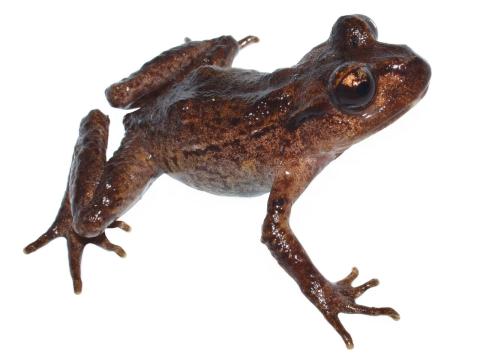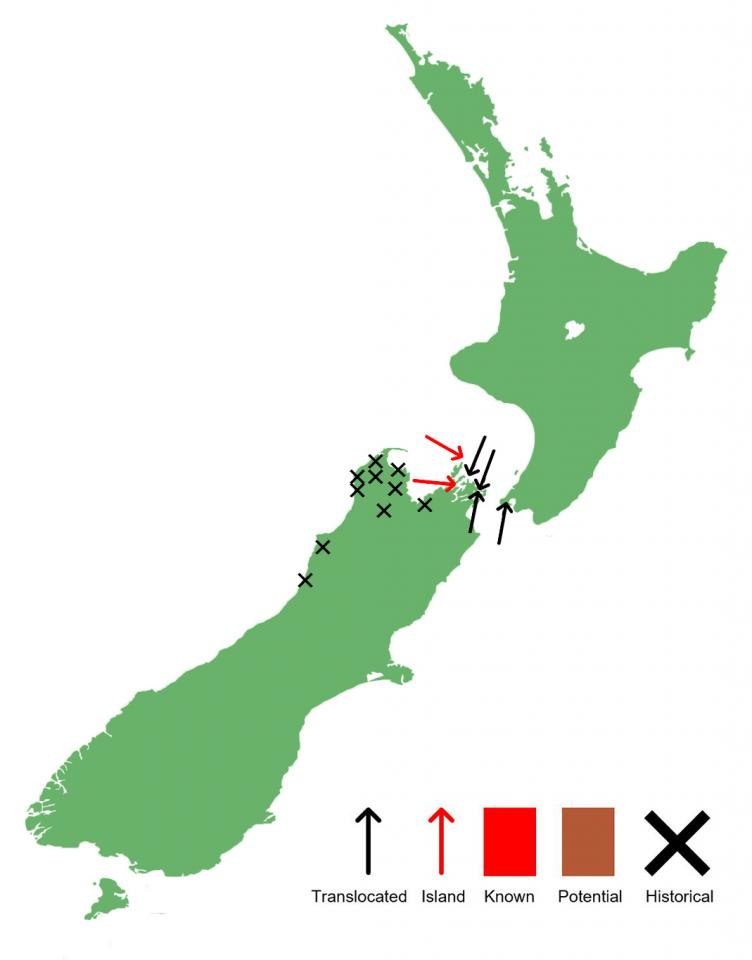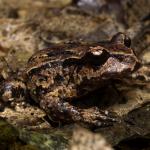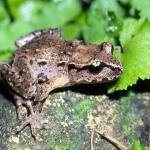Length: SVL: Males up to 43mm; Females up to 52mm
Weight: Up to 10 grams
Description
Aotearoa’s rarest and largest native frog, with some females reaching lengths of 52mm. They were formerly quite widespread (with fossil records indicating a historical presence in Hawke's Bay), but by the time of their discovery were restricted to just two small populations in the Marlborough Sounds.
They are perfectly adapted to the terrestrial environments of the upper South Island, with their patterning and colouration matching the mosaic of leaf litter, and debris that is often found covering the ground in this region. As such their dorsal (upper) surfaces often range from light to dark brown and are often covered with a pattern of black blotches which are most pronounced along the dorsolateral margin (interface between the sides and the dorsal surface). These patterns vary both in coverage and intensity between individuals. Ventral (lower) surfaces are light brown. Hind feet have almost no webbing, which is an adaptation to a terrestrial lifestyle.
Interestingly, although not observed in adults, some young frogs exhibit splashes of green colouration, akin to that seen on some Archey's frogs (Leiopelma archeyi) (Tom Heather pers. comm. 2022).
Similar in appearance to the related Archey's frog (Leiopelma archeyi) which occurs on the Coromandel Peninsula and in Whareorino forest. However, they can be differentiated by their less striking colouration and pattern, as well as by their much larger size and robust build.
Life expectancy
Like our other endemic frog species, Hamilton's frogs are extremely long-lived, with the age records of males and females being 42 years, and 45 years, respectively (Bell et al., 2023).
Distribution
Prior to the colonisation of Aotearoa by humans, Hamilton’s frogs would have had a much greater distribution, occurring from the Hawke's Bay region, through to Wellington, and down to Punakaiki in the South Island, whilst their sister species, Archey's frog (Leiopelma archeyi), would have occurred in the northwestern North Island.
However, at the time of their discovery, they had only survived on Takapourewa/Stephen's Island and Te Pākeka/Maud Island, in the Marlborough Sounds (Worthy, 1987; van Winkel et al., 2018; Bishop et al., 2018).
They have since been translocated from both Maud Island and Stephen's Island to several other islands in the Marlborough Sounds (including Long Island, Motuara Island and Nukuwaiata), and to Zealandia - a mainland sanctuary in Wellington.
Ecology and habitat
Hamilton's frogs are nocturnal and terrestrial, but they are known to climb up into short vegetation (<2 metres). They have a small home range (<5m), and are mainly associated with deep rock piles in native forests, although are also known to live under logs and rocks on the forest floor in the absence of mammalian predators. Frogs emerge from their daytime retreats near dusk and will return to these by dawn. During the day, they typically seek refuge within deep boulder banks, under stones, logs, or in cavities(<1.5m in height) of trees and shrubs. Their emergence at night is associated with relative humidity, rainfall and the wetness of vegetation.
Interestingly, Hamilton's frogs along with their sister species, the Archey's frog (Leiopelma archeyi), exhibit more aggressive defensive tactics than their semi-aquatic cousin. Where the Hochstetter's frog (Leiopelma hochstetteri) tends to quickly move out of harm's way, the terrestrial species take on a rigid headbutting posture. This particular behaviour is strongly associated with the positioning of their secretion glands which are likely a deterrent to would-be predators (Green, 1988).
Social structure
Unlike most frogs, Hamilton's frog, and other Leiopelma, do not vocalize to communicate with members of the same species. Consequently, their breeding and social behaviours are poorly understood. One study demonstrated that chemical cues from Hamilton's frog faeces may play a role in communication and that even size information was able to be communicated. Individuals preferred to spend more time near their own species, rather than faeces from other individuals, and this effect was greatest when the conspecific faeces belonged to a larger frog. Additionally, frogs in this experiment tended to defecate their faeces closer to conspecific faeces, rather than their own (Lee and Waldman 2002). With certain populations reaching high densities (~1000 frogs per hectare) it is unsurprising that these frogs show some form of sociality with congeners, especially in relation to retreat site selection.
As techniques such as radio telemetry become cheaper and more readily available it is likely that we will learn more about their movements and interactions (see Altobelli et al., 2023).
Hamilton's frogs also have an interesting paternal care system, whereby the father guards the eggs deposited by the female, which in turn hatch into tailed froglets that climb onto their father's back and are transported around for several weeks until they are fully developed (Bishop et al. 2013).
Breeding biology
As with all of our endemic frog species, the Hamlton’s frog is oviparous (egg-laying), laying between 1-19 eggs in damp recesses on the ground, in trees, or in the crown of tree ferns. After the deposition of eggs by the female, the male takes sole responsibility for their protection, guarding the eggs until they hatch about 14-21 weeks later. As is the case with its sister species, the Archey's frog (Leiopelma archeyi), tadpoles have no aquatic stage, instead remaining within the egg to hatch out as fully-formed froglets, at which point they are carried around on the male's back for several weeks until metamorphosis is complete (a process often referred to as exovivipary).
Diet
Hamilton's frogs are carnivorous, nocturnal predators feeding on a wide range of invertebrate prey. An analysis of the gut contents of its sister species, the Archey's frog (Leiopelma archeyi), indicated that their prey consisted of springtails, mites, ants, parasitic wasps, amphipods, and isopods (Shaw et al., 2012), as such it is likely that they opportunistically prey on these as well as other invertebrates within their forest ecosystems.
Disease
As is the case with all of Aotearoa's herpetofauna, the diseases and parasites of our endemic Leiopelma frogs are poorly understood, and incomplete. However, one of the greatest threats amphibians are facing is the rapid spread of the deadly chytrid fungus, Batrachochytrium dendrobatidis (Bd). This, and other species of Batrachochytrium have impacted many populations of amphibians around the world (Berger et al. 1999). Some evidence indicates that this may have resulted in a major population crash of its sister species, the Archey's frogs, in the Coromandel during the 1990's (Bell et al. 2004). However, lab and field studies of our native frogs indicate that Leiopelma are highly resistant to this fungus, with some wild individuals persisting after being infected with no obvious adverse effects, whilst captive animals have been seen to eliminate their own infection (Bishop, 2009; Eda et al., 2023)).
Whilst, Bd is a major concern for wild populations, some diseases are more prevalent in captive situations. For example, in captivity, Leiopelma frogs are known to develop metabolic bone disease (MBD) and osteofluorosis (accumulation of fluoride in bones) due to improper husbandry (lack of UVB light, and excess fluoride in water bodies) (Shaw, 2012; Shaw et al., 2012).
Conservation
Hamilton’s frog are listed as ‘vulnerable’ on the IUCN red list. In the 2013 threat classification series DOC listed the Te Pākeka / Maud Island and Takapourewa / Stephen's Island populations separately with Leiopelma hamiltoni (Stephen's Island) categorised as ‘nationally critical’ and Leiopelma pakeka (Maud Island) as ‘nationally vulnerable’ (both groups are now considered to be one species). These populations are collectively listed as Threatened - Nationally Vulnerable, under the most recent threat classification.
Threats to Hamilton’s frog include introduced predators, disease, habitat change and destruction. Intra and inter-island translocations took place in 1992, 2004 and 2006. On Stephens Island tuatara were perceived to be a threat to Hamilton’s frog due to their abundance and the small area the frogs were occupying. In 2006 a group of 21 frogs were translocated from Maud Island to Zealandia Sanctuary.
Interesting notes
The common, and specific name 'hamiltoni' references Harold Hamilton (1885-1937), a biologist who discovered the species on Takapourewa/Stephen's Island (van Winkel et al., 2018).
The Te Pākeka / Maud Island population were named as a separate species (Leiopelma pakeka) in 1998 as a result of allozyme DNA studies, which suggested they were a distinct species. Further genetic studies ensued, it was later postulated that the allozyme data reflected a genetic bottleneck (resulting from the isolation and small size of the populations), and the two groups are now considered to be a single species.
The Hamilton's frog belongs to a clade (group) which includes its sister species Archey's frog (Leiopelma archeyi), and the extinct Waitomo frog (Leiopelma waitomoensis) (Worthy, 1987).
The skeletal morphology of Archey's and Hamilton's frogs are so similar that it is hard to determine their exact historical distribution based on fossil remains (Worthy, 1987).
References
Altobelli, J. T., Bishop, P. J., Dickinson, K. J. M., & Godfrey, S. S. (2023). Suitability of radio telemetry for monitoring two New Zealand frogs (Leiopelma archeyi and L. hamiltoni). New Zealand Journal of Ecology, 47(2), 3532.
Altobelli, J. T., Lamar, S. K., & Bishop, P. J. (2021). Archaic, terrestrial Hamilton’s frogs (Leiopelma hamiltoni) display arboreal behaviours. New Zealand Journal of Ecology, 45(2), 1-6.
Bell, B. D. (1978). Observations on the ecology and reproduction of the New Zealand Leiopelmid frogs. Herpetologica, 340-354.
Bell, B. D. (1994). A review of the status of New Zealand Leiopelma species (Anura: Leiopelmatidae), including a summary of demographic studies in Coromandel and on Maud Island. New Zealand journal of zoology, 21(4), 341-349.
Bell, B. D. (2010). The threatened Leiopelmatid frogs of New Zealand: Natural history integrates with conservation. Herpetological Conservation and Biology, 5(3), 515-528.
Bell, B. D. (2011). Long term population monitoring of the Maud Island frog and Archey’s frog, Victoria University of Wellington. FrogLog, 99, 40-41.
Bell, B. D., Daugherty, C. H., & Hay, J. M. (1998). Leiopelma pakeka, n. sp.(Anura: Leiopelmatidae), a cryptic species of frog from Maud Island, New Zealand, and a reassessment of the conservation status of L. hamiltoni from Stephens Island. Journal of the Royal Society of New Zealand, 28(1), 39-54.
Bell, B. D., Easton, L. J., Walker, K. J., & Woolley, C. K. (2019). Physical contact between a native frog (Leiopelma pakeka) and a carnivorous land snail (Powelliphanta hochstetteri obscura): what was going on?. New Zealand journal of zoology, 46(2), 182-187.
Bell, B. D., & Pledger, S. A. (2010). How has the remnant population of the threatened frog Leiopelma pakeka (Anura: Leiopelmatidae) fared on Maud Island, New Zealand, over the past 25 years?. Austral Ecology, 35(3), 241-256.
Bell, B. D., Pledger, S., & Dewhurst, P. L. (2004). The fate of a population of the endemic frog Leiopelma pakeka (Anura: Leiopelmatidae) translocated to restored habitat on Maud Island, New Zealand. New Zealand Journal of Zoology, 31(2), 123-131.
Bell, B. D., Shirley, A., & Pledger, S. (2023). Post-metamorphic body growth and remarkable longevity in Archey's frog and Hamilton's frog in New Zealand. New Zealand Journal of Ecology, 47(2), 3528.
Bell, B. D., & Wassersug, R. J. (2003). Anatomical features of Leiopelma embryos and larvae: implications for anuran evolution. Journal of Morphology, 256(2), 160-170.
Bell, E. A., & Bell, B. D. (1994). Local distribution, habitat, and numbers of the endemic terrestrial frog Leiopelma hamiltoni on Maud Island, New Zealand. New Zealand journal of zoology, 21(4), 437-442.
Benno Meyer-Rochow, V., & Pehlemann, F. W. (1990). Retinal organisation in the native New Zealand frogs Leiopelma archeyi, L. hamiltoni, and L. hochstetteri (Amphibia: Anura; Leiopelmatidae). Journal of the Royal Society of New Zealand, 20(4), 349-366.
Bishop, P. J., Daglish, L. A., Haigh, A., Marshall, L. J., Tocher, M., & McKenzie, K. L. (2013). Native frog (Leiopelma spp.) recovery plan, 2013-2018: Threatened species recovery plan 63. Department of Conservation, Wellington, New Zealand.
Brown, D. (1994). Transfer of Hamilton's frog, Leiopelma hamiltoni, to a newly created habitat on Stephens Island, New Zealand. New Zealand journal of zoology, 21(4), 425-430.
Burns, R. J., Bell, B. D., Haigh, A., Bishop, P., Easton, L., Wren, S., Germano, J., Hitchmough, R. A., Rolfe, J. R., & Makan, T. (2018). Conservation status of New Zealand amphibians, 2017. New Zealand Threat Classification Series 25: Department of Conservation, Wellington. 7 p.
Cash, B., & Gaze, P. (2008). A history of wildlife translocations in the Marlborough Sounds. DOC: Wellington.
Clay, C., Gleeson, D., Howitt, R., Lawrence, H., Abdelkrim, J., & Gemmell, N. (2010). Characterisation of microsatellite markers for the primitive New Zealand frog, Leiopelma hochstetteri. Conservation Genetics Resources, 2, 301-303.
Daugherty, C. H., Bell, B. D., Adams, M., & Maxson, L. R. (1981). An electrophoretic study of genetic variation in the New Zealand frog genus Leiopelma. New Zealand journal of zoology, 8(4), 543-550.
Daugherty, C. H., Maxson, L. R., & Bell, B. D. (1982). Phylogenetic relationships within the New Zealand frog genus Leiopelma—immunological evidence. New Zealand journal of zoology, 9(2), 239-242.
Easton, L. (2018). Taxonomy and genetic management of New Zealand's Leiopelma frogs (Doctoral dissertation, University of Otago).
Easton, L. J., Rawlence, N. J., Worthy, T. H., Tennyson, A. J., Scofield, R. P., Easton, C. J., Bell, B. D., Whigham, P. A., Dickinson, K. J. M., & Bishop, P. J. (2018). Testing species limits of New Zealand’s leiopelmatid frogs through morphometric analyses. Zoological Journal of the Linnean Society, 183(2), 431-444.
Eda, A. R. A. R., Bishop, P. J., Altobelli, J. T., Godfrey, S. S., & Stanton, J. L. (2023). Screening for Batrachochytrium dendrobatidis in New Zealand native frogs: 20 years on. New Zealand Journal of Ecology, 47(2), 3531.
Egeter, B., Robertson, B. C., & Bishop, P. J. (2015). A synthesis of direct evidence of predation on amphibians in New Zealand, in the context of global invasion biology. Herpetological Review, 46(4), 512-519.
Germano, J. M., Cree, A., & Bishop, P. J. (2011). Ruling out the boys from the girls: can subtle morphological differences identify sex of the apparently monomorphic frog, Leiopelma pakeka?. New Zealand Journal of Zoology, 38(2), 161-171.
Germano, J. M., Earl, R., Tocher, M., Pearce, P., & Christie, J. (2023). The conservation long game: Leiopelma species climate envelopes in New Zealand under a changing climate. New Zealand Journal of Ecology, 47(2), 3535.
Germano, J. M., Molinia, F. C., Bishop, P. J., Bell, B. D., & Cree, A. (2012). Urinary hormone metabolites identify sex and imply unexpected winter breeding in an endangered, subterranean-nesting frog. General and Comparative Endocrinology, 175(3), 464-472.
Germano, J. M., Wren, S., Webster, T., & Bishop, P. J. (2023). Responses at the source and release site following an inter-island translocation of Leiopelma hamiltoni. New Zealand Journal of Ecology, 47(2), 3536.
Gleeson, D., & Molinia, F. (2011). Landcare Research (Auckland). FrogLog, 99, 35.
Green, D. M. (1988). Antipredator behaviour and skin glands in the New Zealand native frogs, genus Leiopelma. New Zealand journal of zoology, 15(1), 39-45.
Green, D. M. (1988). Heteromorphic sex chromosomes in the rare and primitive frog Leiopelma hamiltoni from New Zealand. Journal of heredity, 79(3), 165-169.
Green, D. M., Sharbel, T. F., Hitchmough, R. A., & Daugherty, C. H. (1989). Genetic variation in the genus Leiopelma and relationships to other primitive frogs. Journal of Zoological Systematics and Evolutionary Research, 27(1), 65-79.
Holyoake, A., Waldman, B., & Gemmell, N. J. (2001). Determining the species status of one of the world's rarest frogs: a conservation dilemma. Animal Conservation, 4(1), 29-35.
Jewell, T. (2011). A photographic guide to reptiles and amphibians of New Zealand. Auckland: New Holland Publishing Ltd.
Karst, T. M. (2013). Mortality mitigation of a translocated rare New Zealand frog Leiopelma pakeka: A thesis submitted in partial fulfilment of the requirements for the degree of Master of Science in Conservation Biology.
Karst, T. M., Lukis, K., & Bell, B. D. (2023). Translocation of Hamilton's frog, Leiopelma hamiltoni, to a mainland sanctuary occupied by mice Mus musculus. New Zealand Journal of Ecology, 47(2), 3537.
Lamb, S. D., Altobelli, J. T., Easton, L. J., Godfrey, S. S., & Bishop, P. J. (2022). Captive Hamilton’s frog (Leiopelma hamiltoni) associates non-randomly under retreat sites: Preliminary insights into their social networks. New Zealand Journal of Zoology, 49(3), 236-251.
Lee, J. S., & Waldman, B. (2002). Communication by fecal chemosignals in an archaic frog, Leiopelma hamiltoni. Copeia, 2002(3), 679-686.
Lukis, K. (2009). Returning an endemic frog to the New Zealand mainland: Transfer and adaptive management of Leiopelma pakeka at Karori Sanctuary, Wellington: A thesis submitted to Victoria University of Wellington in partial fulfilment of the requirements for the degree of Master of Science (Ecological Restoration)
Melzer, S., & Bishop, P. J. (2010). Skin peptide defences of New Zealand frogs against chytridiomycosis. Animal Conservation, 13, 44-52.
Melzer, S., & Bishop, P. J. (2011). Just Juice? Attempting to unravel the secrets of skin secretions in New Zealand's endemic frogs. FrogLog, 99, 37-38.
Melzer, S., Clerens, S., & Bishop, P. J. (2011). Differential polymorphism in cutaneous glands of archaic Leiopelma species. Journal of Morphology, 272(9), 1116-1130.
Melzer, S., Davis, L. S., & Bishop, P. J. (2012). Cutaneous gland secretions of Leiopelma pakeka as a potential mechanism against rat predation. New Zealand Journal of Zoology, 39(4), 329-339.
Newman, D. G. (1977). Some evidence of the predation of Hamilton's frog (Leiopelma hamiltoni (McCulloch)) by tuatara (Sphenodon punctatus (Grey)) on Stephens Island. In Proceedings of the New Zealand Ecological Society (Vol. 24, pp. 43-47).
Newman, D. G. (1990). Activity, dispersion, and population densities of Hamilton's frog (Leiopelma hamiltoni) on Maud and Stephens Islands, New Zealand. Herpetologica, 319-330.
Newman, D. G. (1996). Native frog (Leiopelma spp.) Recovery plan: Threatened species recovery plan No. 18. Wellington: Department of Conservation.
Newman, D. G., Bell, B. D., Bishop, P. J., Burns, R., Haigh, A., Hitchmough, R. A., & Tocher, M. (2010). Conservation status of New Zealand frogs, 2009. New Zealand Journal of Zoology, 37(2), 121-130.
Newman, D.G., Bell, B.D., Bishop, P.J., Burns, R.J., Haigh, A., & Hitchmough, R.A. (2013). Conservation status of New Zealand frogs, 2013: In New Zealand Threat Classification Series 5. DOC: Wellington.
Newman, D. G., Crook, I. G., & Imboden, C. H. (1978). Comparisons of the climates of the two habitats of Hamilton's frog (Leiopelma hamiltoni (McCulloch)). New Zealand journal of ecology, 84-90.
Ohmer, M., & Bishop, P. J. (2011). Susceptibility to chytridiomycosis. FrogLog, 99, 38-39.
Ohmer, M. E., Herbert, S. M., Speare, R., & Bishop, P. J. (2013). Experimental exposure indicates the amphibian chytrid pathogen poses low risk to New Zealand's threatened endemic frogs. Animal Conservation, 16(4), 422-429.
Ramírez Saavedra, P. A. (2017). Behavioural patterns of two native Leiopelma frogs and implications for their conservation: a thesis submitted to Victoria University of Wellington in fulfilment of the requirement for the degree of Doctor of Philosophy in Ecology and Biodiversity (Doctoral dissertation, Victoria University).
Ramírez, P. A., Bell, B. D., Germano, J. M., Bishop, P. J., & Nelson, N. J. (2017). Tracking a small cryptic amphibian with fluorescent powders. New Zealand Journal of Ecology, 41(1), 134-138.
Reilly, S., Essner Jr, R., Wren, S., Easton, L., & Bishop, P. J. (2015). Movement patterns in leiopelmatid frogs: insights into the locomotor repertoire of basal anurans. Behavioural Processes, 121, 43-53.
Shaw, S. D. (2012). Diseases of New Zealand native frogs (Doctoral dissertation, James Cook University).
Stephenson, E. M. (1955). The head of the frog, Leiopelma hamiltoni McCulloch. Proceedings of the Zoological Society of London, 124(4), 797-801.
Tocher, M. (2011). 'State of the nation' report on New Zealand translocations including a quick overview of past translocations. FrogLog, 99, 39-40.
Tocher, M. D., Fletcher, D., & Bishop, P. J. (2006). A modelling approach to determine a translocation scenario for the endangered New Zealand frog Leiopelma hamiltoni. The Herpetological Journal, 16(2), 97-106.
van Winkel, D., Baling, M. & Hitchmough, R. (2018). Reptiles and Amphibians of New Zealand: A field guide. Auckland: Auckland University Press, 376 pp.
Waldman, B., & Bishop, P. J. (2004). Chemical communication in an archaic anuran amphibian. Behavioral Ecology, 15(1), 88-93.
Webster, J. T. (2004). Individual identification, disease monitoring and home range of Leiopelma hamiltoni: a thesis submitted in partial fulfilment of the requirements for the Degree of Master of Zoology.
Worthy, T. H. (1987). Osteology of Leiopelma (Amphibia: Leiopelmatidae) and descriptions of three new subfossil Leiopelma species. Journal of the Royal Society of New Zealand, 17(3), 201-251.
Worthy, T. H. (1987). Palaeoecological information concerning members of the frog genus Leiopelma: Leiopelmatidae in New Zealand. Journal of the Royal Society of New Zealand, 17(4), 409-420.
Wren, S., Bishop, P. J., Beauchamp, A. J., Bell, B. D., Bell, E., Cisternas, J., Dewhurst, P., Easton, L., Gibson, R., Haigh, A., Tocher, M., & Germano, J. M. (2023). A review of New Zealand native frog translocations: lessons learned and future priorities. New Zealand Journal of Ecology, 47(2), 3538.




